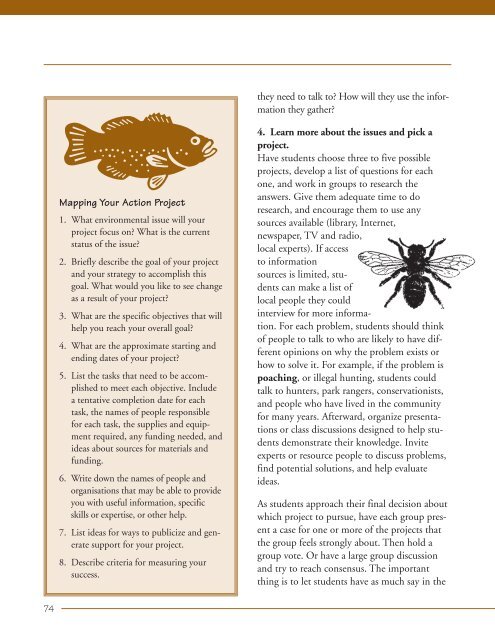EXPLORING BIODIVERSITY: A Guide for Educators Around the World
EXPLORING BIODIVERSITY: A Guide for Educators Around the World
EXPLORING BIODIVERSITY: A Guide for Educators Around the World
Create successful ePaper yourself
Turn your PDF publications into a flip-book with our unique Google optimized e-Paper software.
Mapping Your Action Project<br />
1. What environmental issue will your<br />
project focus on? What is <strong>the</strong> current<br />
status of <strong>the</strong> issue?<br />
2. Briefly describe <strong>the</strong> goal of your project<br />
and your strategy to accomplish this<br />
goal. What would you like to see change<br />
as a result of your project?<br />
3. What are <strong>the</strong> specific objectives that will<br />
help you reach your overall goal?<br />
4. What are <strong>the</strong> approximate starting and<br />
ending dates of your project?<br />
5. List <strong>the</strong> tasks that need to be accomplished<br />
to meet each objective. Include<br />
a tentative completion date <strong>for</strong> each<br />
task, <strong>the</strong> names of people responsible<br />
<strong>for</strong> each task, <strong>the</strong> supplies and equipment<br />
required, any funding needed, and<br />
ideas about sources <strong>for</strong> materials and<br />
funding.<br />
6. Write down <strong>the</strong> names of people and<br />
organisations that may be able to provide<br />
you with useful in<strong>for</strong>mation, specific<br />
skills or expertise, or o<strong>the</strong>r help.<br />
7. List ideas <strong>for</strong> ways to publicize and generate<br />
support <strong>for</strong> your project.<br />
8. Describe criteria <strong>for</strong> measuring your<br />
success.<br />
/<br />
<strong>the</strong>y need to talk to? How will <strong>the</strong>y use <strong>the</strong> in<strong>for</strong>mation<br />
<strong>the</strong>y ga<strong>the</strong>r?<br />
4. Learn more about <strong>the</strong> issues and pick a<br />
project.<br />
Have students choose three to five possible<br />
projects, develop a list of questions <strong>for</strong> each<br />
one, and work in groups to research <strong>the</strong><br />
answers. Give <strong>the</strong>m adequate time to do<br />
research, and encourage <strong>the</strong>m to use any<br />
sources available (library, Internet,<br />
newspaper, TV and radio,<br />
local experts). If access<br />
to in<strong>for</strong>mation<br />
sources is limited, students<br />
can make a list of<br />
local people <strong>the</strong>y could<br />
interview <strong>for</strong> more in<strong>for</strong>mation.<br />
For each problem, students should think<br />
of people to talk to who are likely to have different<br />
opinions on why <strong>the</strong> problem exists or<br />
how to solve it. For example, if <strong>the</strong> problem is<br />
poaching, or illegal hunting, students could<br />
talk to hunters, park rangers, conservationists,<br />
and people who have lived in <strong>the</strong> community<br />
<strong>for</strong> many years. Afterward, organize presentations<br />
or class discussions designed to help students<br />
demonstrate <strong>the</strong>ir knowledge. Invite<br />
experts or resource people to discuss problems,<br />
find potential solutions, and help evaluate<br />
ideas.<br />
As students approach <strong>the</strong>ir final decision about<br />
which project to pursue, have each group present<br />
a case <strong>for</strong> one or more of <strong>the</strong> projects that<br />
<strong>the</strong> group feels strongly about. Then hold a<br />
group vote. Or have a large group discussion<br />
and try to reach consensus. The important<br />
thing is to let students have as much say in <strong>the</strong><br />
74

















